完全倒装
完全倒装和部分倒装的区别例句

完全倒装和部分倒装的区别例句完全倒装和部分倒装的区别例句如下:一、完全倒装完全倒装是指将句子中的谓语动词全部置于主语之前.完全倒装的句子通常只用一般现在时和过去时.1、Here,There,Now,Then等副词放在句首时,句子要完全倒装,谓语动词常用come,go,be,lie,run等.例如:①There comes the bus!②Now comes your turn.2、表示方位的副词或介词短语置于句首时,句子要完全倒装,句中的谓语动词是come,go等表示运动的动词.①The door opened and in came the headmaster.②Up and up went the prices.③High flew the plane.注意:①上述完全倒装句中主语如为人称代词,应放在动词前面.Here comes Mr.Lee.Here he comes.Auay went the students.Auay they went.②有时为了句子的平衡或强调,将表语置于句首,也属于完全倒装.例如:Gone are the days when we used the foreign oil.二、部分倒装部分倒装是指将谓语动词的一部分如助动或情态动词置于主语之前.1、否定副词如no,not,never,seldom,little,hardly,以及含有no,not的短语放在句首时,句子要部分倒装.①Never in my life have I heard such a thing.②Little did we expect that he could come.③Not a single word did he say at the meeting.④By no means should we do like this.注意:如上述句子中的否定副词不置于句首时,句子结构不倒装.2、以否定词开头的关联结构注意:No sooner…than…,Hardly/scarcely…when…,Not only…but also,Not until…①Not until late in the evening did he come back.②Hardly had he got on the bus when he heard a shout.③Not only did he buy a bike for me but he also sent it to my house.注意:No sooner…than…;hardly…when;not only…but also这类句型,只将前半部分倒装,后半部分用正常语序.3、当only置于句首修饰状语时,句子要部分倒装.①Only in this way can we learn English well.②Only when he is seriously ill does he ever stay in bed.4、so,neither,nor在句首表示“也”或“也不”句子要部分倒装.①Tom is very kind.So am I.②I like English.So does Jack.③I can’t speak English.Nor/Neither can he.注意:so 后主、谓语不倒装表示前面所述内容的肯定、确定.试比较:Tom is very kind.So am I.(两个人,一样情形)Tom is very kind.So he is.(一个人,一种情形)汤姆非常和蔼.他就是如此.5、由as/though引导的让步状语从句,从句形成倒装.①Child as he was,he could speak five languages.②Hard as he work,you can’t support your family.③Try as you do,you will ever win.注意:表语为单数名词时,不定冠词“a”应被省去.She–maker as he was,he was very happy.6、so…that/such…that句型中so,such 位于句首时,句子要部分倒装.①So fast does light travel that it is difficult for us to imagine its speed.7、省略了if 的虚拟条件从句中,主谓形成了部分倒装(虚拟语气的条件句中,省略if 后,had,were,should等应提前)①Had you told me earlier,I could have done something .②Should anyone call,tell him to call in the afternoon.③Were I you,I would try it again.。
完全倒装句的用法归纳总结
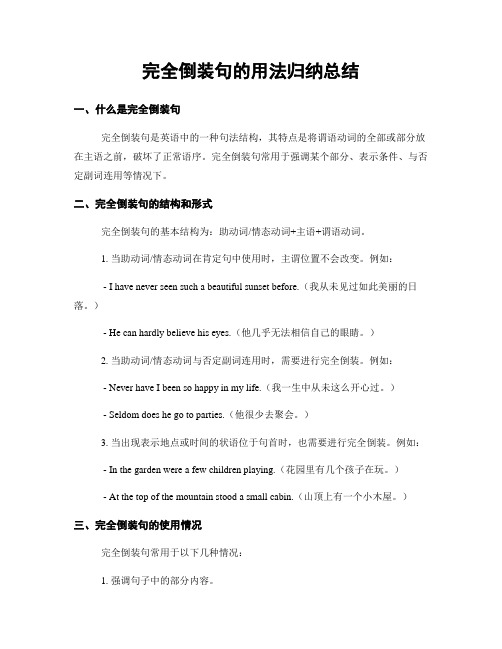
完全倒装句的用法归纳总结一、什么是完全倒装句完全倒装句是英语中的一种句法结构,其特点是将谓语动词的全部或部分放在主语之前,破坏了正常语序。
完全倒装句常用于强调某个部分、表示条件、与否定副词连用等情况下。
二、完全倒装句的结构和形式完全倒装句的基本结构为:助动词/情态动词+主语+谓语动词。
1. 当助动词/情态动词在肯定句中使用时,主谓位置不会改变。
例如:- I have never seen such a beautiful sunset before.(我从未见过如此美丽的日落。
)- He can hardly believe his eyes.(他几乎无法相信自己的眼睛。
)2. 当助动词/情态动词与否定副词连用时,需要进行完全倒装。
例如:- Never have I been so happy in my life.(我一生中从未这么开心过。
)- Seldom does he go to parties.(他很少去聚会。
)3. 当出现表示地点或时间的状语位于句首时,也需要进行完全倒装。
例如:- In the garden were a few children playing.(花园里有几个孩子在玩。
)- At the top of the mountain stood a small cabin.(山顶上有一个小木屋。
)三、完全倒装句的使用情况完全倒装句常用于以下几种情况:1. 强调句子中的部分内容。
在一般陈述句中,我们可以通过将谓语动词放在主语之前来强调句子中的某个成分,特别是状语。
例如:- Only when you face your fears can you overcome them.(只有当你面对恐惧时,你才能克服它们。
)2. 表示条件或让步关系。
在表示条件或让步关系的从句中,我们经常使用完全倒装句。
例如:- Should you need any assistance, please feel free to contact us.(如果您需要任何帮助,请随时联系我们。
英语全部倒装和部分倒装

倒装分全部倒装和部分倒装1、完全倒装(Full Inversion):又称”全部倒装",是指将句子中的谓语全部置于主语之前。
此结构通常只用于一般现在时和一般过去时。
谓语+主语+……①There be(的各种形式)+主语(+地点或时间状语)例子:There was a drop in the temperature.温度下降了There are brids singing in the tree。
鸟儿在树上唱歌。
②副词小品词+谓语动词+名词主语+……例子:Out rushed a young lady。
③过去分词或现在分词+be的各种形式+主语+……例子:Scattered on the floor were several books and magazines.几本书和杂志散落在地板上2。
部分倒装(Partial Inversion)(又称半倒装句):指将谓语的一部分如助动词或情态动词倒装至主语之前,而谓语动词无变化.如果句中的谓语没有助动词或情态动词,则需添加助动词do,does或did,并将其置于主语之前。
英语句子的倒装一是由于语法结构的需要而进行的倒装,二是由于修辞的需要而进行的倒装。
前一种情况,倒装是必须的,否则就会出现语法错误;后一种情况,倒装是选择性的,倒装与否只会产生表达效果上的差异。
表示强调倒装句最突出、最常见的修辞效果就是强调,其表现形式如下:1。
only +状语或状语从句置于句首,被该状语修饰的句子用部分倒装。
例子:Only in this way can you solve this problem.只有用这种方法,你才可以解决这个问题。
Only after he had spoken out the word did he realize he had made a big mistake.只有当他已经说出那个字后才意识到自己犯了个大错误。
2。
hardly,in no way,little,scarcely,seldom,never,no more,no longer,not,not only,no sooner,not only … (but also),not until… 等具有否定意义的词或词组位于句首,句子用部分倒装。
完全倒装句的用法归纳及例句
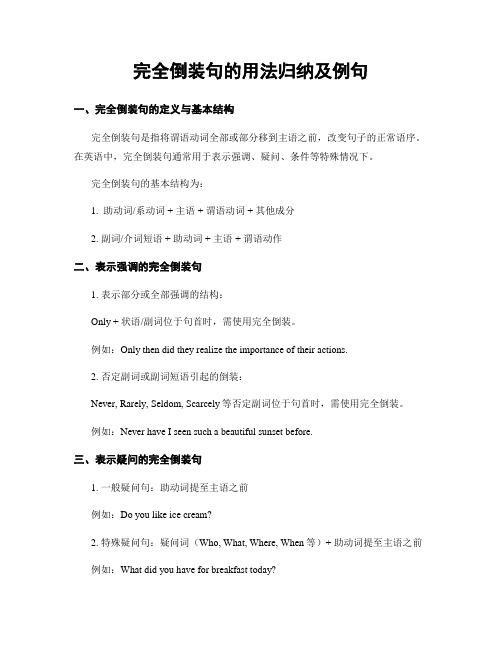
完全倒装句的用法归纳及例句一、完全倒装句的定义与基本结构完全倒装句是指将谓语动词全部或部分移到主语之前,改变句子的正常语序。
在英语中,完全倒装句通常用于表示强调、疑问、条件等特殊情况下。
完全倒装句的基本结构为:1. 助动词/系动词 + 主语 + 谓语动词 + 其他成分2. 副词/介词短语 + 助动词 + 主语 + 谓语动作二、表示强调的完全倒装句1. 表示部分或全部强调的结构:Only + 状语/副词位于句首时,需使用完全倒装。
例如:Only then did they realize the importance of their actions.2. 否定副词或副词短语引起的倒装:Never, Rarely, Seldom, Scarcely等否定副词位于句首时,需使用完全倒装。
例如:Never have I seen such a beautiful sunset before.三、表示疑问的完全倒装句1. 一般疑问句:助动词提至主语之前例如:Do you like ice cream?2. 特殊疑问句:疑问词(Who, What, Where, When等)+ 助动词提至主语之前例如:What did you have for breakfast today?四、表示条件的完全倒装句1. 条件引导词位于句首:Should, Had等条件引导词位于句首时,需使用完全倒装。
例如:Had he studied harder, he would have passed the exam.2. Only if引导的条件从句部分完全倒装:Only if引导的条件状语从句需使用主谓颠倒的语序。
例如:Only if you apologize will she forgive you.五、例句示范1. 强调句:Only in winter does it snow heavily in this area.On weekends do I have time to relax and enjoy hobbies.2. 疑问句:Can they speak French?Why are you so upset?2.43. 数据测试失败原因演示:5月1日-5日,我所做任务的模型尚未被训练到此,数据测试不涉及当前任务特性。
全部倒装句例子
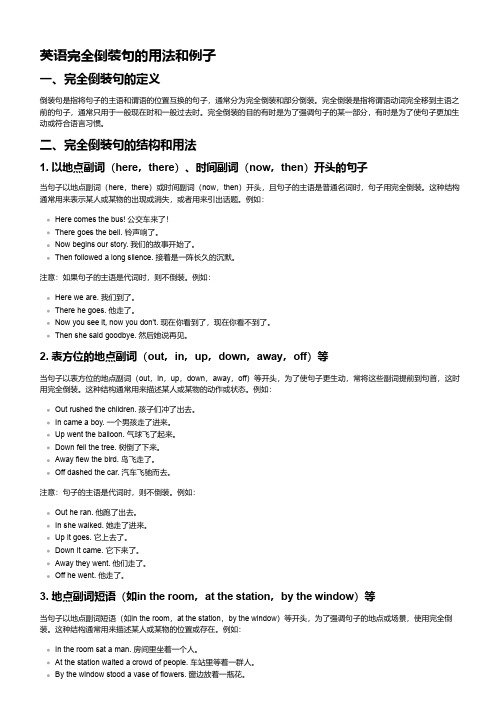
英语完全倒装句的用法和例子一、完全倒装句的定义倒装句是指将句子的主语和谓语的位置互换的句子,通常分为完全倒装和部分倒装。
完全倒装是指将谓语动词完全移到主语之前的句子,通常只用于一般现在时和一般过去时。
完全倒装的目的有时是为了强调句子的某一部分,有时是为了使句子更加生动或符合语言习惯。
二、完全倒装句的结构和用法1. 以地点副词(here,there)、时间副词(now,then)开头的句子当句子以地点副词(here,there)或时间副词(now,then)开头,且句子的主语是普通名词时,句子用完全倒装。
这种结构通常用来表示某人或某物的出现或消失,或者用来引出话题。
例如:Here comes the bus! 公交车来了!There goes the bell. 铃声响了。
Now begins our story. 我们的故事开始了。
Then followed a long silence. 接着是一阵长久的沉默。
注意:如果句子的主语是代词时,则不倒装。
例如:Here we are. 我们到了。
There he goes. 他走了。
Now you see it, now you don't. 现在你看到了,现在你看不到了。
Then she said goodbye. 然后她说再见。
2. 表方位的地点副词(out,in,up,down,away,off)等当句子以表方位的地点副词(out,in,up,down,away,off)等开头,为了使句子更生动,常将这些副词提前到句首,这时用完全倒装。
这种结构通常用来描述某人或某物的动作或状态。
例如:Out rushed the children. 孩子们冲了出去。
In came a boy. 一个男孩走了进来。
Up went the balloon. 气球飞了起来。
Down fell the tree. 树倒了下来。
Away flew the bird. 鸟飞走了。
完全倒装与部分倒装
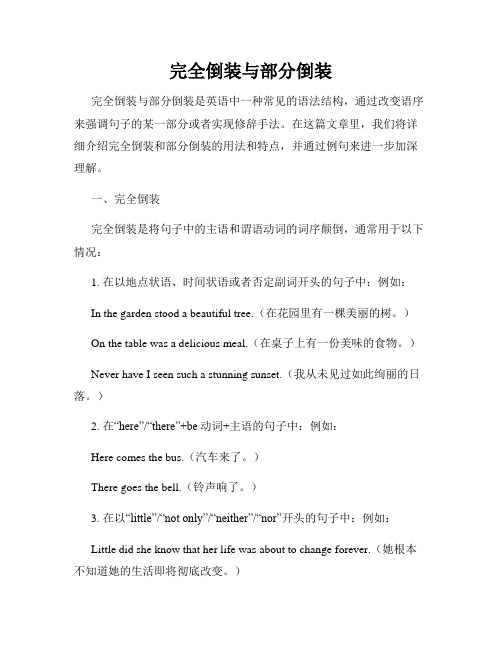
完全倒装与部分倒装完全倒装与部分倒装是英语中一种常见的语法结构,通过改变语序来强调句子的某一部分或者实现修辞手法。
在这篇文章里,我们将详细介绍完全倒装和部分倒装的用法和特点,并通过例句来进一步加深理解。
一、完全倒装完全倒装是将句子中的主语和谓语动词的词序颠倒,通常用于以下情况:1. 在以地点状语、时间状语或者否定副词开头的句子中:例如:In the garden stood a beautiful tree.(在花园里有一棵美丽的树。
)On the table was a delicious meal.(在桌子上有一份美味的食物。
)Never have I seen such a stunning sunset.(我从未见过如此绚丽的日落。
)2. 在“here”/“there”+be动词+主语的句子中:例如:Here comes the bus.(汽车来了。
)There goes the bell.(铃声响了。
)3. 在以“little”/“not only”/“neither”/“nor”开头的句子中:例如:Little did she know that her life was about to change forever.(她根本不知道她的生活即将彻底改变。
)Not only is he intelligent, but he is also kind-hearted.(他不仅聪明,而且心地善良。
)Neither did I agree with his decision, nor did I understand his reasoning.(我既不同意他的决定,也不理解他的理由。
)二、部分倒装部分倒装是将助动词、情态动词或者“be”动词与主语的词序颠倒,同样用于强调句子的某一部分或者实现修辞手法。
常见的部分倒装情况包括:1. 在以否定词开头的句子中:例如:Never have I been so inspired.(我从未如此受到鼓舞。
完全倒装句语法
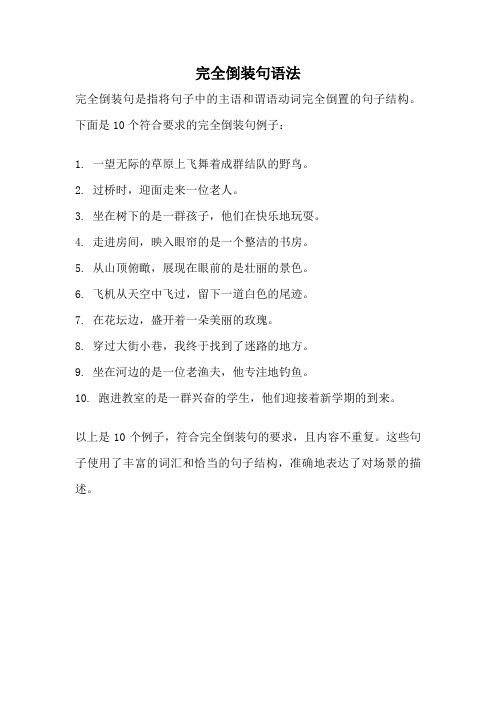
完全倒装句语法
完全倒装句是指将句子中的主语和谓语动词完全倒置的句子结构。
下面是10个符合要求的完全倒装句例子:
1. 一望无际的草原上飞舞着成群结队的野鸟。
2. 过桥时,迎面走来一位老人。
3. 坐在树下的是一群孩子,他们在快乐地玩耍。
4. 走进房间,映入眼帘的是一个整洁的书房。
5. 从山顶俯瞰,展现在眼前的是壮丽的景色。
6. 飞机从天空中飞过,留下一道白色的尾迹。
7. 在花坛边,盛开着一朵美丽的玫瑰。
8. 穿过大街小巷,我终于找到了迷路的地方。
9. 坐在河边的是一位老渔夫,他专注地钓鱼。
10. 跑进教室的是一群兴奋的学生,他们迎接着新学期的到来。
以上是10个例子,符合完全倒装句的要求,且内容不重复。
这些句子使用了丰富的词汇和恰当的句子结构,准确地表达了对场景的描述。
倒装句

倒装句: 倒装句:完全倒装
• • • • • • • 4)起飞的命令到了。 )起飞的命令到了。 5)他们告别的时候到了。 )他们告别的时候到了。 6)鸟扑的一声飞跑了。 )鸟扑的一声飞跑了。 7)杰克走了。 )杰克走了。 8)她左边坐着她丈夫。 )她左边坐着她丈夫。 9)有个老渔夫住在河的对岸。 )有个老渔夫住在河的对岸。 10)玛丽站在客人中间。 )玛丽站在客人中间。
倒装句练习:段落翻译(综合练习) 倒装句练习:段落翻译(综合练习)
• • • • • • • • I. Warm-up Exercises: 词汇复习 …雕 ( e ) 雕 …虾 (s ) 虾 …黄昏 (d ) 黄昏 …呻吟 …呻吟 (g ) …患……病( s ) 患 病 …丰盛 (r )/ (s ) 丰盛 …消化不良 (in ) 消化不良
倒装句: 倒装句:完全倒装
• 注意:如果在以方向词、方位词开始的句子中的主语是代 注意:如果在以方向词、 则不能倒装。 词,则不能倒装。 • 例: • 1. There he comes. • 2. Here they are. • 3. Here it is.
倒装句: 倒装句:完全倒装
• 特别提醒:尽管在以方位词、方向词为首的句子中,若主 特别提醒:尽管在以方位词、方向词为首的句子中, 语是代词则不能倒装,但是 当我们表示对情况概述时, 但是, 语是代词则不能倒装 但是,当我们表示对情况概述时, 我们可以说so 助动词+主语 我们可以说 can we, so +助动词 主语 与助动词相呼 助动词 主语+与助动词相呼 应的动词形式。 应的动词形式。 • • • • 例: They can leave now, so can we. You have helped her, and so has she you. He loves the girl. So does she him.
完全倒装与部分倒装(精选)
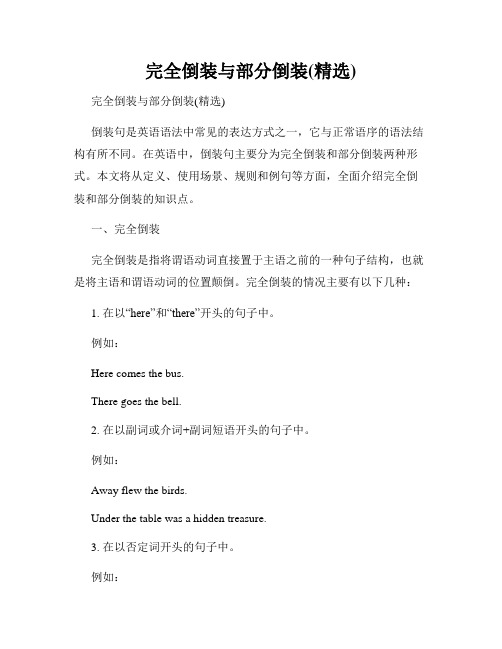
完全倒装与部分倒装(精选)完全倒装与部分倒装(精选)倒装句是英语语法中常见的表达方式之一,它与正常语序的语法结构有所不同。
在英语中,倒装句主要分为完全倒装和部分倒装两种形式。
本文将从定义、使用场景、规则和例句等方面,全面介绍完全倒装和部分倒装的知识点。
一、完全倒装完全倒装是指将谓语动词直接置于主语之前的一种句子结构,也就是将主语和谓语动词的位置颠倒。
完全倒装的情况主要有以下几种:1. 在以“here”和“there”开头的句子中。
例如:Here comes the bus.There goes the bell.2. 在以副词或介词+副词短语开头的句子中。
例如:Away flew the birds.Under the table was a hidden treasure.3. 在以否定词开头的句子中。
例如:Never have I seen such a beautiful sunset.Not only did he pass the exam, but he also got the highest score.4. 在以“only”开头的句子中。
例如:Only in this way can we solve the problem.Only when we work together can we achieve success.二、部分倒装部分倒装是指将助动词、情态动词或连系动词置于主语之前的一种句子结构。
部分倒装常常出现在以下情况下:1. 在以否定词开头的句子中。
例如:Never have I been so disappointed.At no time did she mention the incident.2. 在以“so”开头表示结果的句子中。
例如:So excited was he that he couldn't fall asleep.So tired was she that she couldn't continue the journey.3. 在以“not only...but also...”开头的句子中。
高中语法辨析倒装句的完全与部分倒装
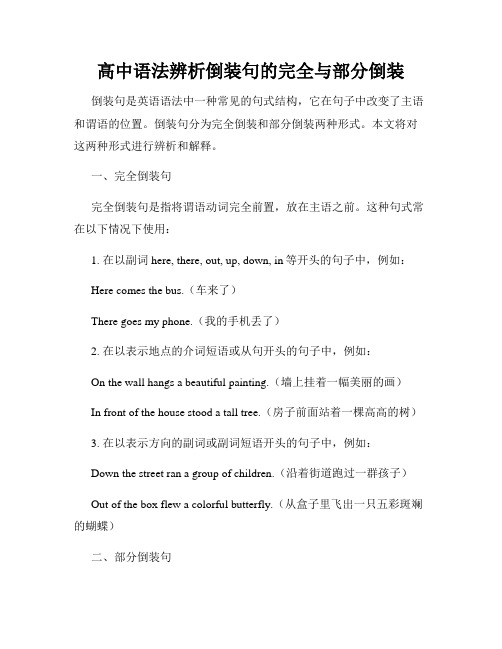
高中语法辨析倒装句的完全与部分倒装倒装句是英语语法中一种常见的句式结构,它在句子中改变了主语和谓语的位置。
倒装句分为完全倒装和部分倒装两种形式。
本文将对这两种形式进行辨析和解释。
一、完全倒装句完全倒装句是指将谓语动词完全前置,放在主语之前。
这种句式常在以下情况下使用:1. 在以副词here, there, out, up, down, in等开头的句子中,例如:Here comes the bus.(车来了)There goes my phone.(我的手机丢了)2. 在以表示地点的介词短语或从句开头的句子中,例如:On the wall hangs a beautiful painting.(墙上挂着一幅美丽的画)In front of the house stood a tall tree.(房子前面站着一棵高高的树)3. 在以表示方向的副词或副词短语开头的句子中,例如:Down the street ran a group of children.(沿着街道跑过一群孩子)Out of the box flew a colorful butterfly.(从盒子里飞出一只五彩斑斓的蝴蝶)二、部分倒装句部分倒装句是指将助动词或情态动词与主语之间的其他成分倒装,谓语动词仍然位于主语之后。
这种句式常在以下情况下使用:1. 在以表示否定意义的副词或词组开头的句子中,例如:Never have I seen such a beautiful sunset.(我从未见过如此美丽的日落)Under no circumstances should you give up.(无论如何,你都不应该放弃)2. 在以谓语动词的否定形式开头的句子中,例如:Not only does she play the piano, but she also sings.(她不仅会弹钢琴,还会唱歌)No sooner had I arrived home than it started raining.(我一到家就开始下雨)3. 在以“so + 形容词/副词 + 助动词/情态动词”结构开头的句子中,例如:So beautiful is the scenery that I want to stay here forever.(风景如此美丽,我想永远呆在这里)So quickly can he solve the math problem that it astonishes everyone.(他能如此快地解决这道数学题,让每个人都惊讶)总结:完全倒装句和部分倒装句在使用场景和结构上有所不同。
完全倒装句
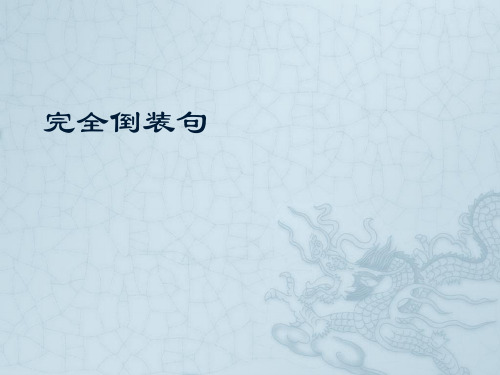
3. There __a__r_e___ (be) so many people at the entrance.
4. At the bottom of the bed __i_s_______ (be) the stocking.
5. In front of the stadium _s_t_a_n__d__s__ (stand) many students.
3,表示方位的副词位于句首时,往往用完 全Байду номын сангаас装句。
In comes our teacher. Away went the students. Out rush the children.
注意:完全倒装一般要满足两个条件:
1,谓语动词是单个的不及物动词,一般只限 于一般现在时或一般过去时;
2,主语必须时名词,不能为代词。如果是代 词,要用正常的主谓语序。
Here comes the bus. There is some money in my pocket. Now comes your turn. Then came the most exciting moment.
2,表示方位的介词短语位于句首时,通常 用完全倒装。
Under the tree stands our English teacher. In the front of the class sat a boy.
6. On the top of the mountain ___a_r_e___ (be) some beautiful flowers.
7. There __g_o__e_s__ (go) the bell. 8. Around the corner __w__a__lk__s_ (walk) a young
完全倒装句例句
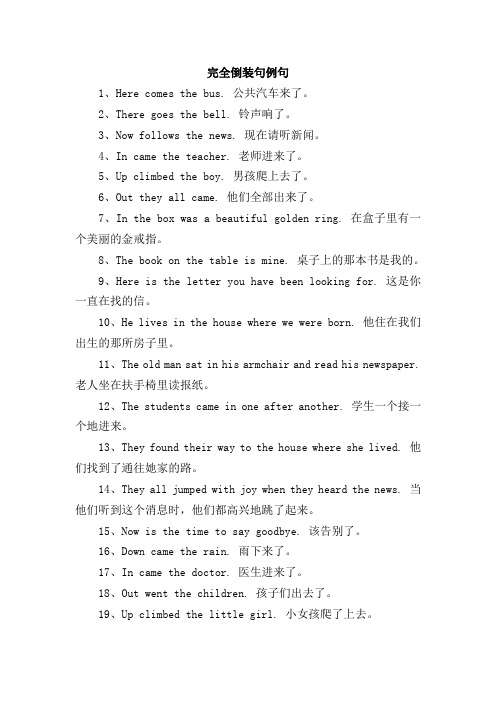
完全倒装句例句1、Here comes the bus. 公共汽车来了。
2、There goes the bell. 铃声响了。
3、Now follows the news. 现在请听新闻。
4、In came the teacher. 老师进来了。
5、Up climbed the boy. 男孩爬上去了。
6、Out they all came. 他们全部出来了。
7、In the box was a beautiful golden ring. 在盒子里有一个美丽的金戒指。
8、The book on the table is mine. 桌子上的那本书是我的。
9、Here is the letter you have been looking for. 这是你一直在找的信。
10、He lives in the house where we were born. 他住在我们出生的那所房子里。
11、The old man sat in his armchair and read his newspaper. 老人坐在扶手椅里读报纸。
12、The students came in one after another. 学生一个接一个地进来。
13、They found their way to the house where she lived. 他们找到了通往她家的路。
14、They all jumped with joy when they heard the news. 当他们听到这个消息时,他们都高兴地跳了起来。
15、Now is the time to say goodbye. 该告别了。
16、Down came the rain. 雨下来了。
17、In came the doctor. 医生进来了。
18、Out went the children. 孩子们出去了。
19、Up climbed the little girl. 小女孩爬了上去。
高中高考英语专题:倒装句语法知识汇总(全倒和半倒)
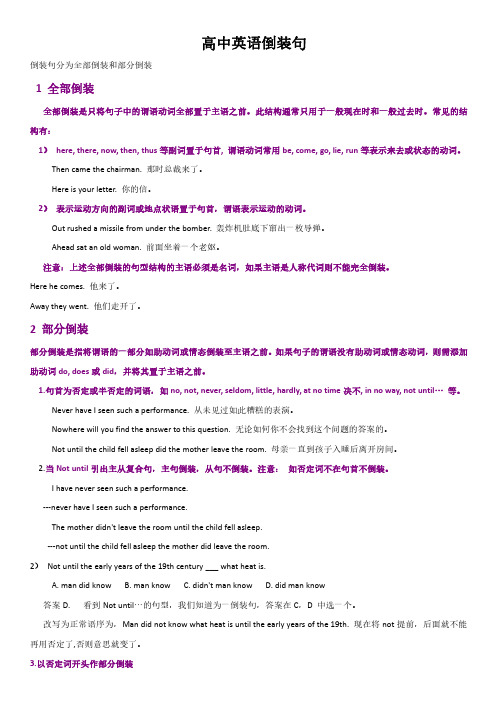
高中英语倒装句倒装句分为全部倒装和部分倒装1全部倒装全部倒装是只将句子中的谓语动词全部置于主语之前。
此结构通常只用于一般现在时和一般过去时。
常见的结构有:1)here,there,now,then,thus等副词置于句首,谓语动词常用be,come,go,lie,run等表示来去或状态的动词。
Then came the chairman.那时总裁来了。
Here is your letter.你的信。
2)表示运动方向的副词或地点状语置于句首,谓语表示运动的动词。
Out rushed a missile from under the bomber.轰炸机肚底下窜出一枚导弹。
Ahead sat an old woman.前面坐着一个老妪。
注意:上述全部倒装的句型结构的主语必须是名词,如果主语是人称代词则不能完全倒装。
Here he comes.他来了。
Away they went.他们走开了。
2部分倒装部分倒装是指将谓语的一部分如助动词或情态倒装至主语之前。
如果句子的谓语没有助动词或情态动词,则需添加助动词do,does或did,并将其置于主语之前。
1.句首为否定或半否定的词语,如no,not,never,seldom,little,hardly,at no time决不,in no way,not until…等。
Never have I seen such a performance.从未见过如此糟糕的表演。
Nowhere will you find the answer to this question.无论如何你不会找到这个问题的答案的。
Not until the child fell asleep did the mother leave the room.母亲一直到孩子入睡后离开房间。
2.当Not until引出主从复合句,主句倒装,从句不倒装。
注意:如否定词不在句首不倒装。
I have never seen such a performance.---never have I seen such a performance.The mother didn't leave the room until the child fell asleep.---not until the child fell asleep the mother did leave the room.2)Not until the early years of the19th century___what heat is.A.man did knowB.man knowC.didn't man knowD.did man know答案D.看到Not until…的句型,我们知道为一倒装句,答案在C,D中选一个。
全部倒装的几种情况
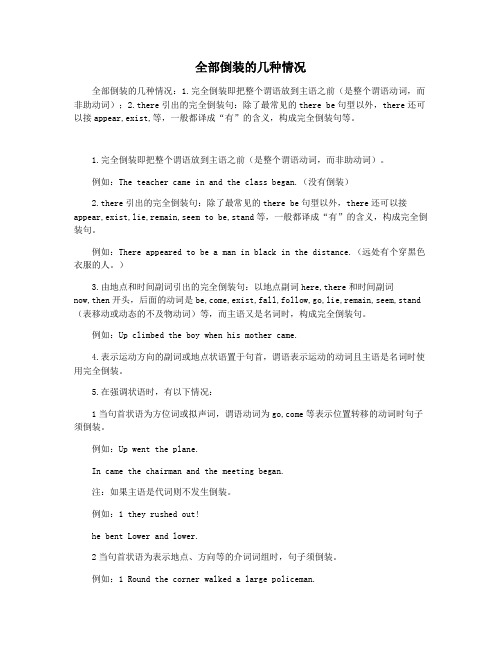
全部倒装的几种情况全部倒装的几种情况:1.完全倒装即把整个谓语放到主语之前(是整个谓语动词,而非助动词);2.there引出的完全倒装句:除了最常见的there be句型以外,there还可以接appear,exist,等,一般都译成“有”的含义,构成完全倒装句等。
1.完全倒装即把整个谓语放到主语之前(是整个谓语动词,而非助动词)。
例如:The teacher came in and the class began.(没有倒装)2.there引出的完全倒装句:除了最常见的there be句型以外,there还可以接appear,exist,lie,remain,seem to be,stand等,一般都译成“有”的含义,构成完全倒装句。
例如:There appeared to be a man in black in the distance.(远处有个穿黑色衣服的人。
)3.由地点和时间副词引出的完全倒装句:以地点副词here,there和时间副词now,then开头,后面的动词是be,come,exist,fall,follow,go,lie,remain,seem,stand (表移动或动态的不及物动词)等,而主语又是名词时,构成完全倒装句。
例如:Up climbed the boy when his mother came.4.表示运动方向的副词或地点状语置于句首,谓语表示运动的动词且主语是名词时使用完全倒装。
5.在强调状语时,有以下情况:1当句首状语为方位词或拟声词,谓语动词为go,come等表示位置转移的动词时句子须倒装。
例如:Up went the plane.In came the chairman and the meeting began.注:如果主语是代词则不发生倒装。
例如:1 they rushed out!he bent Lower and lower.2当句首状语为表示地点、方向等的介词词组时,句子须倒装。
完全倒装的四种类型

完全倒装的四种类型完全倒装的基本形式是“谓语+主语”,主要涉及以下几种类型:一、here类当表示地点的here和 there位于句首时,其后用完全倒装形式。
这类倒装句的谓语通常是动词be和come, go等表示移动或动态的不及物动词。
如:Here’s Tom. 汤姆在这里。
There’s Jim. 吉姆在那儿。
Here comes the bus. 公共汽车来了。
There goes the bell. 铃响了。
There goes the last train. 最后一班火车开走了。
这类倒装句的主语只能是名词,若主语为代词,则不能倒装。
如:Here it comes. 它来了。
二、away类副词away, down, in, off, out, over, round, up 等位于句首时,其后也用完全倒装语序。
这类倒装句的谓语通常表示动态的不及物动词。
如:Away went the runners. 赛跑选手们跑远了。
Round and round flew the plane. 飞机盘旋着。
The door opened and in came Mr Smith. 门开了,史密斯先生进了来。
Down came the rain and up went the umbrellas. 下雨了,伞都撑起来了。
这类倒装句的主语也只能是名词,若主语为代词,则不用倒装。
如:Away he went. 他跑远了。
Down it came. 它掉了下来。
三、状语或表语类为了保持句子平衡或使上下文衔接紧密,有时可将状语或表语置于句首,句中主语和谓语完全倒装。
如:Among these people was his friend Jim. 他的朋友吉姆就在这些人当中。
By the window sat a young man with a magazine in his hand. 窗户边坐着一个年轻人,手里拿着一本杂志。
部分倒装与完全倒装的区别
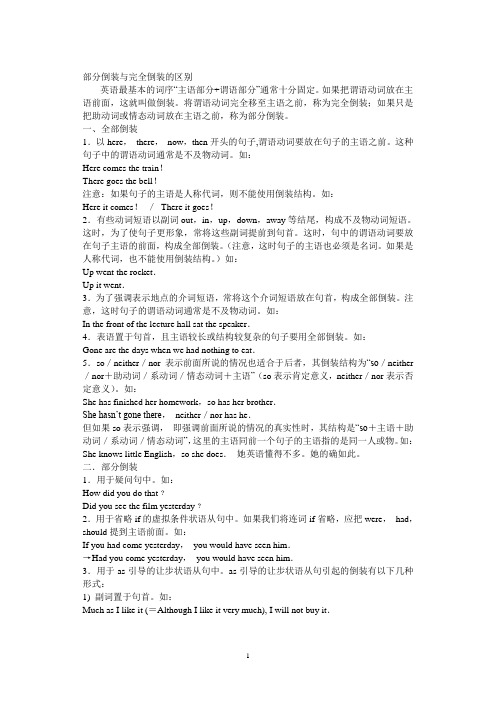
部分倒装与完全倒装的区别英语最基本的词序“主语部分+谓语部分”通常十分固定。
如果把谓语动词放在主语前面,这就叫做倒装。
将谓语动词完全移至主语之前,称为完全倒装;如果只是把助动词或情态动词放在主语之前,称为部分倒装。
一、全部倒装1.以here,there,now,then开头的句子,谓语动词要放在句子的主语之前。
这种句子中的谓语动词通常是不及物动词。
如:Here comes the train!There goes the bell!注意:如果句子的主语是人称代词,则不能使用倒装结构。
如:Here it comes!/There it goes!2.有些动词短语以副词out,in,up,down,away等结尾,构成不及物动词短语。
这时,为了使句子更形象,常将这些副词提前到句首。
这时,句中的谓语动词要放在句子主语的前面,构成全部倒装。
(注意,这时句子的主语也必须是名词。
如果是人称代词,也不能使用倒装结构。
)如:Up went the rocket.Up it went.3.为了强调表示地点的介词短语,常将这个介词短语放在句首,构成全部倒装。
注意,这时句子的谓语动词通常是不及物动词。
如:In the front of the lecture hall sat the speaker.4.表语置于句首,且主语较长或结构较复杂的句子要用全部倒装。
如:Gone are the days when we had nothing to eat.5.so/neither/nor表示前面所说的情况也适合于后者,其倒装结构为“so/neither /nor+助动词/系动词/情态动词+主语”(so表示肯定意义,neither/nor表示否定意义)。
如:She has finished her homework,so has her brother.She hasn’t gone there,neither/nor has he.但如果so表示强调,即强调前面所说的情况的真实性时,其结构是“so+主语+助动词/系动词/情态动词”,这里的主语同前一个句子的主语指的是同一人或物。
完全倒装句

完全倒装句完全倒装倒装句完全倒装和部分倒装完全倒装句练习部分倒装句完全倒装句例句完全倒装句so完全倒装句英语倒装句讲解
倒装句的含义
• 倒装(Inversion)是一种语法手段,它是相对正常语序而
言的。我们通常把主语在前谓语在后看 作正常语序,如
陈 述句。如果使用与正常语序相反语序的句子,就叫做
倒装句。 • 使用倒装通常是出于语法结构的需要,有时也是为了强调。
•
2)Out he ran
• 七、表“地点”的词语置句首或强调“地点”概念时
• Eg:On the table were some flowers.
•
Between the two buildings stands a tall tree.
•
South of the city lies a stee
• “Both,sir.”he answered proudly.
• 十、祝愿句完全倒装。如:
• Long live peace!和平万岁!
补充说明
• 寻找完全倒装标志
• 1.here,there,in,out,up,down,away等介词、副词放在句 首时应使用完全倒装句型。例如:
• There goes the bell.铃响了。 • Away flew the bird.鸟飞走了。 • 注意 使用完全倒装的主语必须是名词,如果是人称代词则不能使用
完全倒装与部分倒装

完全倒装与局部倒装1. 完全倒装1) 完全倒装即把整个谓语放到主语之前(是整个谓语动词,而非助动词)。
例如:In came the teacher and the class began. (老师走了进来,然后开始上课。
)2) there引出的完全倒装句:除了最常见的there be句型以外,there还能够接appear, exist, lie, remain, seem to be, stand等,一般都译成"有"的含义,构成完全倒装句。
例如:There appeared to be a man in black in the distance.(远处有个穿黑色衣服的人。
)3) 由地点和时间副词引出的完全倒装句:以地点副词here, there和时间副词now, then 开头,后面的动词是be, come, exist, fall, follow, go, lie, remain, seem, stand等,而主语又是名词时,构成完全倒装句。
例:Under that tree sits a beautiful girl.(那棵树下坐着一位美丽的姑娘。
)例:Down jumped the burglar from the tenth floor when the policeman pointed his pistol at him.注意:1) 在here, there引出的倒装句中,当主语是普通名词时用完全倒装句,但当主语是代词时,就要用局部倒装句。
例:Here comes the postman!(邮递员终于来了!注意实意谓语动词位于主语之前。
)Here we are.(我们到了。
注意系动词位于主语代词之后。
)2) 注意正语序和倒装语序的语气、意义是区别:例:Here is the picture I love.(这正是我所喜爱的画。
)The picture I love is here.(我所喜爱的画在这里。
完全倒装的四种类型

完全倒装的四种类型完全倒装的基本形式是“谓语+主语”,主要涉及以下几种类型:一、here类当表示地点的here和 there位于句首时,其后用完全倒装形式。
这类倒装句的谓语通常是动词be和come, go等表示移动或动态的不及物动词。
如:Here’s Tom. 汤姆在这里。
There’s Jim. 吉姆在那儿。
Here comes the bus. 公共汽车来了。
There goes the bell. 铃响了。
There goes the last train. 最后一班火车开走了。
这类倒装句的主语只能是名词,若主语为代词,则不能倒装。
如:Here it comes. 它来了。
二、away类副词away, down, in, off, out, over, round, up 等位于句首时,其后也用完全倒装语序。
这类倒装句的谓语通常表示动态的不及物动词。
如:Away went the runners. 赛跑选手们跑远了。
Round and round flew the plane. 飞机盘旋着。
The door opened and in came Mr Smith. 门开了,史密斯先生进了来。
Down came the rain and up went the umbrellas. 下雨了,伞都撑起来了。
这类倒装句的主语也只能是名词,若主语为代词,则不用倒装。
如:Away he went. 他跑远了。
Down it came. 它掉了下来。
三、状语或表语类为了保持句子平衡或使上下文衔接紧密,有时可将状语或表语置于句首,句中主语和谓语完全倒装。
如:Among these people was his friend Jim. 他的朋友吉姆就在这些人当中。
By the window sat a young man with a magazine in his hand. 窗户边坐着一个年轻人,手里拿着一本杂志。
- 1、下载文档前请自行甄别文档内容的完整性,平台不提供额外的编辑、内容补充、找答案等附加服务。
- 2、"仅部分预览"的文档,不可在线预览部分如存在完整性等问题,可反馈申请退款(可完整预览的文档不适用该条件!)。
- 3、如文档侵犯您的权益,请联系客服反馈,我们会尽快为您处理(人工客服工作时间:9:00-18:30)。
完全倒装
所谓完全倒装,就是将谓语动词置于主语前。
1.表方位或时间的副词或介词短语,如here, there, now, then, out, in, up, down, off, away,in the room,on the wall等置于句首,此时,①句子主语必须是名词;②谓语动词通常是be或者come, go, run, rush, fly, follow, fall等表示位移的不及物动词,且为一般时态(一般现在时或者一般过去时;③其中的here, there不是表示地点,而是用以引起对方注重。
如:There goes the bell. 铃响了。
Out rush the children.
On the top of the hill stands an old temple. 这山顶上有一座庙。
There is a tall tree in front of the house. 这房子前面有一棵树。
2.若直接引语的部分或全部放在句首,并且说话人是名词时,将say或ask置于说话人前,构成完全倒装。
如:
“Are you ready?” asked the teacher. “预备好了没有?”老师问道。
“It is unbelievable!” said Alfred Butts. 阿尔弗雷德·布滋说,“这真叫人难以置信!”
3. 用于“表语+be动词+主语”的结构中。
当表达方式主语部分太长,“be动词+表语”部分太短,句式不够平衡,此类倒装主要是为了维持句式的平衡。
常见的例句有:
Gone are the days when we are short of food and clothing.
Present at the meeting are some famous scientists and some important leaders
练习
1. Look, ________.
A. here the bus comes
B. here is the bus coning
C. here comes the bus
D. here the bus is coming
2.—Where is Kate?
—Look,_______, she is at the school gate.
A. there she is
B. there is she
C. here you are
D. here it is
3. Which of the following sentences is correct?
A. In the teacher came
B. In did come the teacher
C. In did the teacher come
D. In came the teacher
4. Out _____, with a stick in his hand.
A. did he rush
B. rushed he
C. he rushed
D. he did rush
5. On the wall two large portraits.
A. hangs
B. hang
C. is hanging
D. are hanging。
